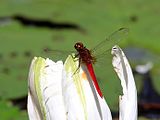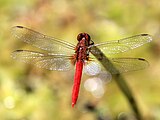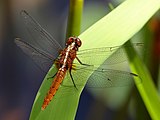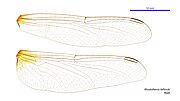
Orthetrum villosovittatum, known as the fiery skimmer, is a species of dragonfly in the family Libellulidae. Its range is from the Moluccas, New Guinea and neighbouring islands as well as Australia. In Australia it is found in Victoria through eastern New South Wales and Queensland, north inland Queensland, Cape York Peninsula and north Northern Territory. It is a common species through most of its range.
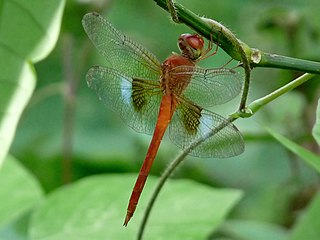
Tholymis tillarga, the coral-tailed cloudwing, is a species of dragonfly in the family Libellulidae. It is found from tropical West Africa to Asia, Australia and the Pacific Islands. Common names include old world twister, evening skimmer, crepuscular darter, foggy-winged twister and twister.

Tramea is a genus of dragonflies in the family Libellulidae, the skimmers and perchers. Species of Tramea are found in tropical and subtropical regions around the globe. They typically have colored bases to their otherwise translucent hindwings. In particular when they fly, this creates the impression of their carrying bags at the start of their abdomens. They are known commonly as saddlebags or saddlebags gliders.

Anax guttatus, the pale-spotted emperor or lesser green emperor, is a dragonfly of the family Aeshnidae.
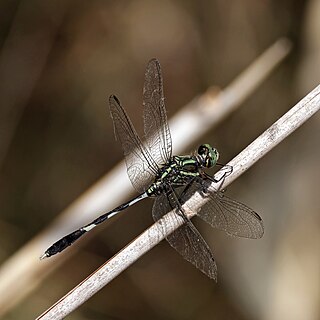
Orthetrum sabina, the slender skimmer or green marsh hawk, is a species of dragonfly in the family Libellulidae. It is widespread, being found from south-eastern Europe and North Africa to Japan and south to Australia and Micronesia.
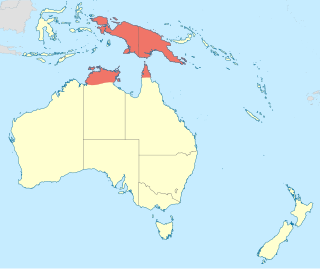
Orthetrum balteatum is a freshwater dragonfly species in the family Libellulidae, present in northern Australia and New Guinea. The common name for this species is speckled skimmer.

Orthetrum serapia, the green skimmer, is a freshwater dragonfly in the family Libellulidae. The serapia species is present in Australia, the Philippines, Fiji, Papua New Guinea and Solomon Islands. It inhabits a wide range of still and sluggish waters, often shallow. In Australia it ranges from the top end of the Northern Territory to about Mackay in central Queensland.

Potamarcha congener, also known as the yellow-tailed ashy skimmer, common chaser, or swampwatcher, is a species of dragonfly in the family Libellulidae. It was first described by Jules Pierre Rambur in 1842, almost fifty years before Friedrich Karsch described its genus. Potamarcha congener is one of two species making up the genus Potamarcha, together with Potamarcha puella.

Rhyothemis graphiptera, known as the graphic flutterer or banded flutterer, is a species of dragonfly of the family Libellulidae. It is found across northern Australia, the Moluccas, New Guinea and New Caledonia. Rhyothemis extends from Africa to the western Pacific.
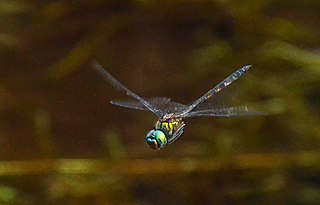
Hemicordulia asiatica, Asian emerald, is a species of dragonfly in the family Corduliidae.

Zyxomma petiolatum, known by the common names long-tailed duskdarter, brown dusk hawk and dingy duskflyer, is a species of dragonfly in the family Libellulidae. It is widespread in many Asian countries, New Guinea, northern Australia and islands in the Pacific.

Nannodiplax rubra, commonly called the pygmy percher, is a species of dragonfly in the monotypic genus Nannodiplax. Its distribution seems to be limited to Australia and New Guinea. They are tiny dragonflies with a bright red abdomen and clear wings. They are found near a wide variety of rivers and streams. The Australian distribution ranges from Broome, Western Australia via the north and east to around Coffs Harbour, New South Wales. The taxon has not yet been assessed for the IUCN Red List, but it is listed in the Catalogue of Life.

Rhyothemis princeps, known as the sapphire flutterer, is a species of dragonfly of the family Libellulidae. The flight of the genus Rhyothemis is usually fluttering, leading to the common description of "flutterer" for most species in the genus.
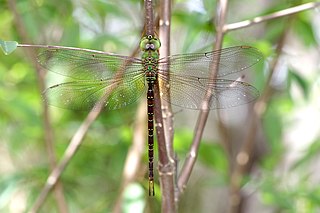
Gynacantha rosenbergi is a species of dragonfly in the family Aeshnidae, known as the grey duskhawker. It inhabits still waters and is found in New Guinea, Indonesia, through parts of northern Australia, as well as islands in the south Pacific.
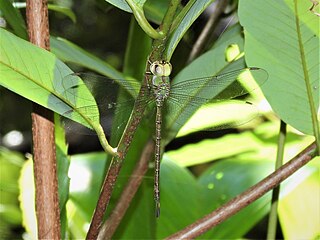
Gynacantha dobsoni is a species of dragonfly in the family Aeshnidae, known as the lesser duskhawker. It inhabits ponds and swamps and is found in northern Australia.

Dendroaeschna is a monotypic genus of Australian dragonflies in the family Brachytronidae. The only known species of this genus is Dendroaeschna conspersa, commonly known as a wide-faced darner.

Austrocordulia refracta is a species of dragonfly in the family Austrocorduliidae, commonly known as the eastern hawk. It is a medium-sized, dull brown dragonfly, endemic to eastern Australia, where it inhabits streams and pools.

Micromidia rodericki is a species of dragonfly in the family Austrocorduliidae, known as the Thursday Island mosquitohawk. It is a very small, black to metallic green dragonfly with pale markings on its abdomen. It is endemic to Thursday Island, Australia, in Torres Strait, where it inhabits rainforest streams.

Agriocnemis dobsoni is a species of damselfly in the family Coenagrionidae, commonly known as a tropical wisp. It is a small damselfly; mature males have a white pruinescence over their body, and a dark end to their tail. It is endemic to north-eastern Australia, where it inhabits pools and swamps.






